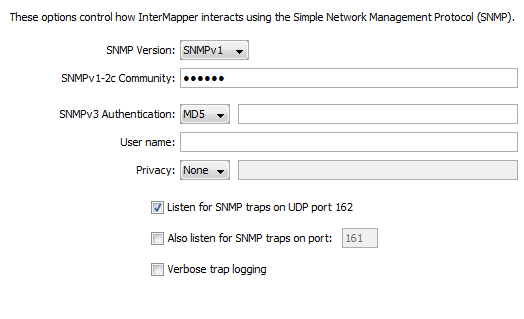SNMP Preferences
You can use the SNMP subsection of the Server Preferences section to set the default SNMP settings for each SNMP access method. These settings are used for all new devices.
SNMP Versions
Intermapper can retrieve data from devices using SNMP version 1, version 2c, or version 3. Each of these can access the same SNMP information, but through the following means:
- SNMPv1 is the original version and provides a simple means for retrieving data. Security is provided through community strings that act like passwords to allow or deny access to the information. The Read-Only community string provides permission to the requester to read data and the Read-Write community string provides permission to modify data. All data transmissions (including the community string) are sent in the clear (unencrypted).
- SNMPv2c provides additional, more efficient methods to request data and adds new data types (such as 64-bit counters) so the monitoring system can gather more accurate data. SNMPv2c is like SNMPv1 in that it uses the same community string system and transmits data in the clear (unencrypted).
- SNMPv3 provides the same data retrieval facilities as SNMPv2c, but with additional security. This is a secure method of providing authentication information (so the device knows whether to respond to the query or not), as well as a privacy function that encrypts the entire transmission so that eavesdroppers cannot discern the data.
What is an SNMP Community String?
The SNMP Read-only Community string is like a user id or password that allows access to a router's or other device's statistics. Intermapper sends the community string along with all SNMP requests. If the community string is correct, the device responds with the requested information. If the community string is incorrect, the device ignores the request and does not respond.
Community String Types
The following community strings are available for SNMPv1-v2c-speaking devices:
- SNMP Read-only community string - enables a remote device to retrieve read-only information from a device. Intermapper uses this information on its maps.
- SNMP Read-Write community string - used when requesting information from a device and when modifying settings on that device. Intermapper does not use the read-write community string, since it never attempts to modify any settings on its devices.
- SNMP Trap community string - included when a device sends SNMP Traps to Intermapper. Intermapper accepts any SNMP Trap community string.
By convention, most SNMPv1-v2c equipment ships from the factory with a read-only community string set to public. It is standard practice for network managers to change all the community strings so that outsiders cannot see information about the internal network. (In addition, network managers might employ firewalls to block any SNMP traffic to ports 161 and 162 on the internal network.)
SNMP Server Settings Pane
Intermapper remembers the default settings for each of the various SNMP access methods. These are set in the Server Settings > SNMP preference pane.

This pane allows you to specify the following:
- SNMP Version - the default SNMP version to be used for new devices in autodiscovery. Intermapper attempts to use the selected version when it discovers a new device. If it gets a response, it continues to use that version. If that fails, it pings the device.
- SNMPv1-2c Community - if the selected SNMP version is SNMPv1 or SNMPv2c, Intermapper uses this community string to attempt communication with the device.
- SNMPv3 Authentication - if the selected SNMP version is SNMPv3, Intermapper uses the specified authentication method (SHA, MD5, or None) with the indicated password on the right to authenticate with the device. As of 6.6.0, SHA-2 is supported for SNMPv3 Authentication with the following bits: 224, 256, 384, and 512.
- User Name - the SNMPv3 user name used for authentication and privacy.
- Privacy - When using SNMPv3, the privacy method (DES, AES, or None) is used with the encryption password on the right. Intermapper also uses AES 128 with SNMPv3.
- Listen for SNMP Traps on UDP Port 162 - select this check box if you want Intermapper to listen for SNMP traps sent from devices to the standard port 162.
- Also listen for SNMP traps on UDP port - Intermapper can listen for traps on a second, non-standard port (in addition to port 162). Select this check box and enter the port number in the text box. Traps received on this alternate port are handled in the same manner as those received on port 162.
- Verbose trap logging - select this check box to display the full OID and contents for all varbinds of a trap, instead of simply the varbind contents.
Setting SNMP Preferences for Specific Devices
The panel shown above sets the default SNMP preferences that Intermapper uses when querying devices. You can also set SNMP preferences for individual devices on your map using the Set Community... (SNMPv1-v2c) or Set Probe (all three SNMP versions) commands, available from the Monitor menu. You can set various parameters for one or more devices at a time by selecting the devices you want to change before executing the command.